What’s in Bloom Now? April Garden Update
By Thea Hegland
April is the month most symbolic of the quintessential spring here at The Butchart Gardens. Just imagine meandering through a dizzying haze of Cherry and Plum blossoms, the delicate petals drifting through the air. Softly scented, these iconic flowering trees of spring can lock us into a mesmerizing trance.
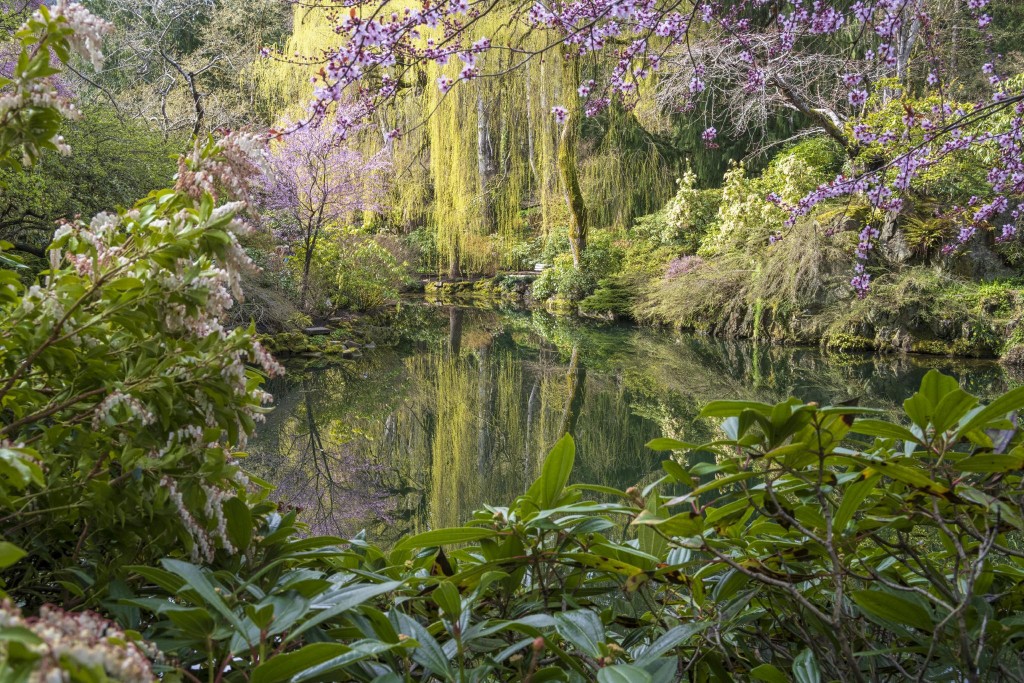 The captive nature of spring reflected in the Sunken Garden Lake
The captive nature of spring reflected in the Sunken Garden Lake
Often confused, there are some fairly easy ways to note the differences between these two trees. Both are members of the large genus of Prunus. Similar from afar but let’s take a closer look at the key differences. Plum trees generally flower first; followed by Cherries. The Plum flowers have quite a strong fragrance; Cherry blossoms have a more subtle fragrance. Most ornamental Plums have a reddish leaf, while few varieties have a green leaf. Cherries have green leaves. The flower buds are round on Plums as opposed to oval on Cherries. Look at the tree trunk and note the bark. A Plum tree has a dark, rough bark whereas a Cherry tree is easily identified by the lenticels. These are horizontal lines that appear broken in rings around the gray bark of a Cherry tree. Simple? Not so fast…it is important to note that some Cherry trees are commonly grafted on Plum rootstock for ornamental purposes.
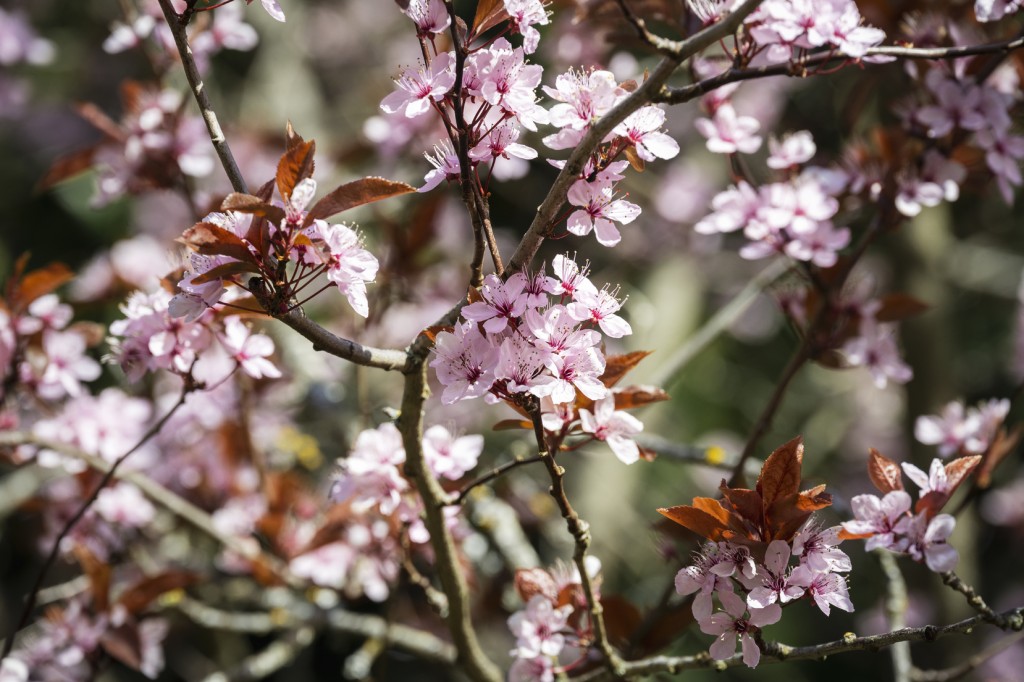 Plum tree blossoms identified by the reddish leafs
Plum tree blossoms identified by the reddish leafs
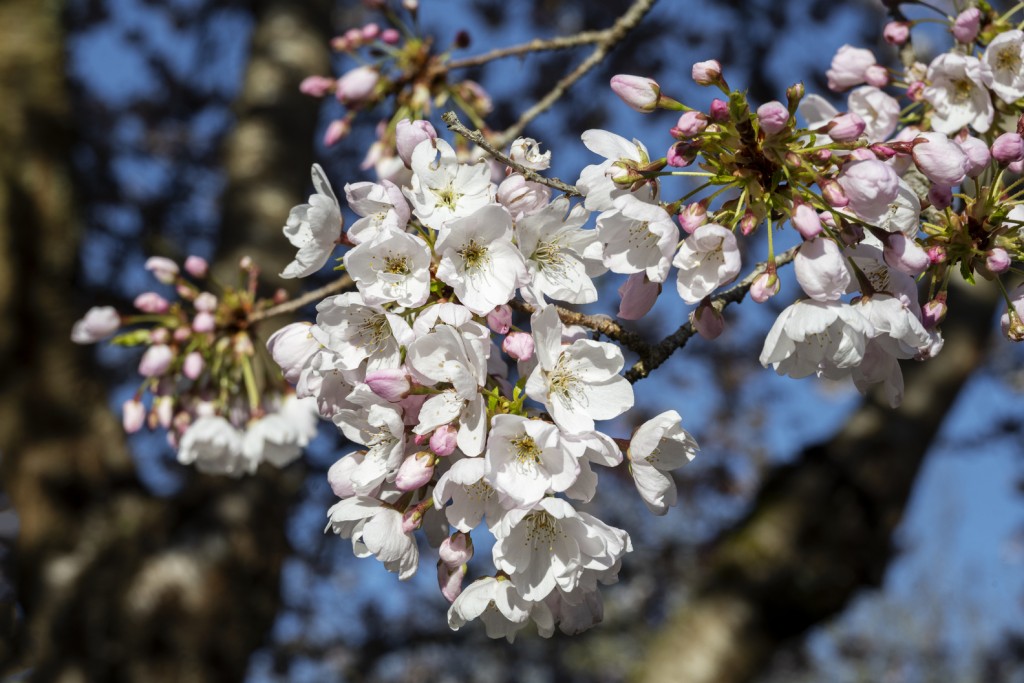 Cherry tree blossoms identified by the green leaves and oval shaped buds
Cherry tree blossoms identified by the green leaves and oval shaped buds
Not to be lost amongst all the beauty of the flowering Prunus, The Gardens are also home to an impressive collection of an ancient genus –Magnolia. These trees have a history dating back millions of years ago, believed to have derived before bees evolved. More than 28 varieties can be found flowering at The Gardens in April. With a life span anywhere from 80 -120 years, records indicate that some of the oldest specimens found onsite date back to Jennie Butchart’s original plantings. Perhaps the most remarkable is the Magnolia soulangeana planted near the Butchart family residence, just outside Jennie’s Private Garden along the path to The Dining Room.
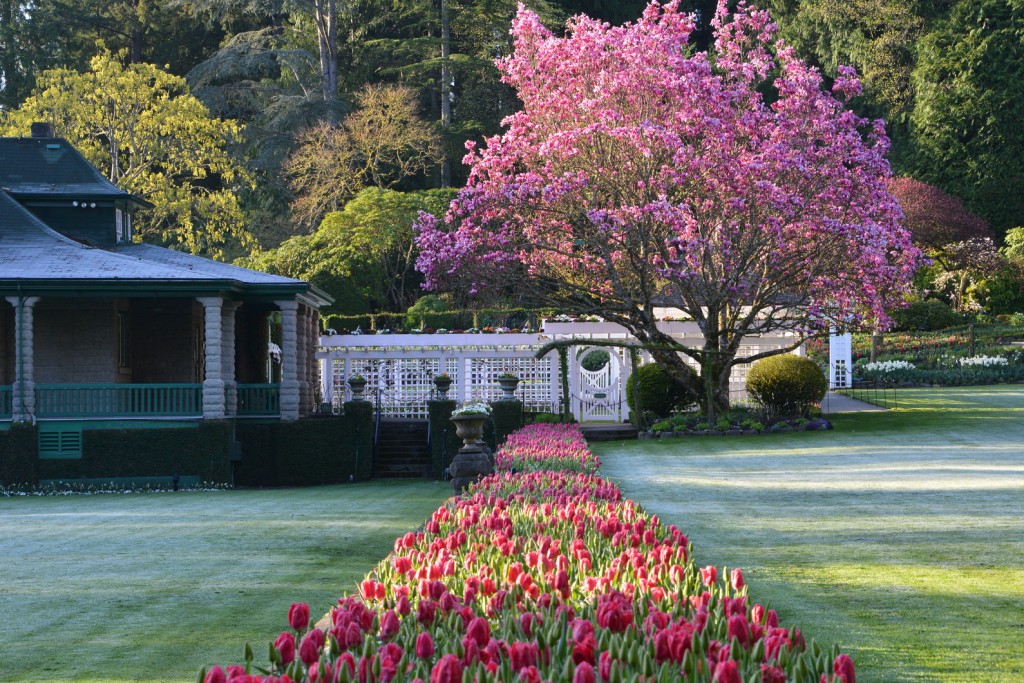 Magnolia soulangeana planted outside the Dining Room Restaurant, the original home of the Butchart family
Magnolia soulangeana planted outside the Dining Room Restaurant, the original home of the Butchart family
April is the month to best enjoy the Tulips, which are widely considered the most famous spring flower. Every fall, Tulip bulbs are shipped from Holland and Prince Edward Island and by April, The Gardens are dazzling with a brilliant display of Tulipa. – The Holy Grail of spring. More than 185 varieties make up the 160, 000 Tulip bulbs that are now poised and ready to stun us all with their elegant beauty.
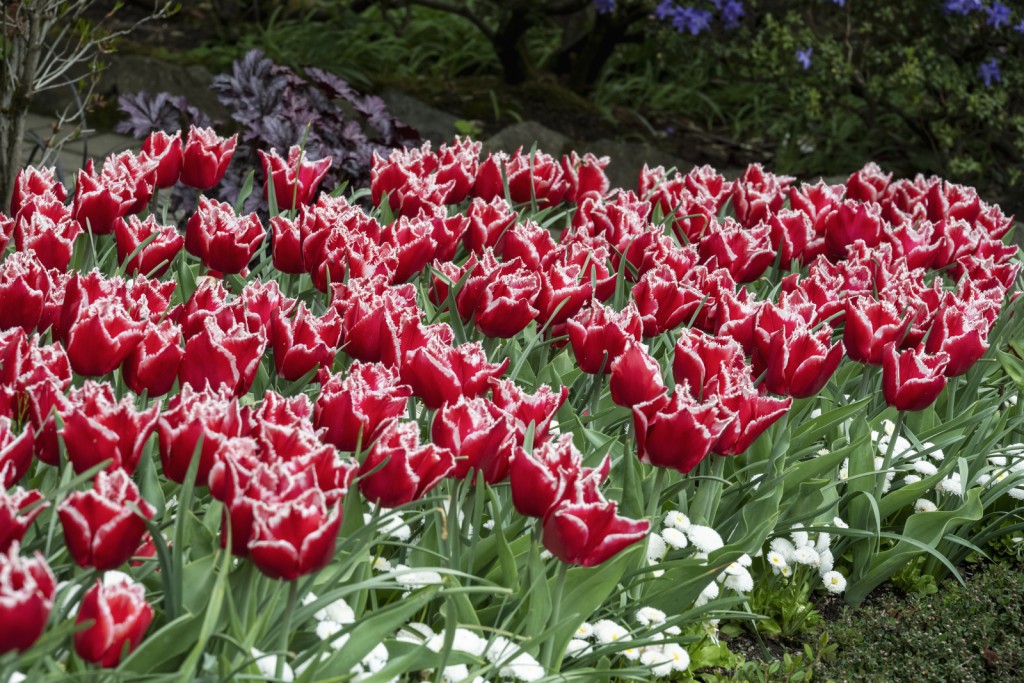 Brilliant Tulip display
Brilliant Tulip display
Also noteworthy during April are the all Hyacinthus (Hyacinth), Narcissus (Daffodil), and the gorgeous blue Myosotis (Forget-me-not) underplanting’s that Jennie Butchart loved so much.
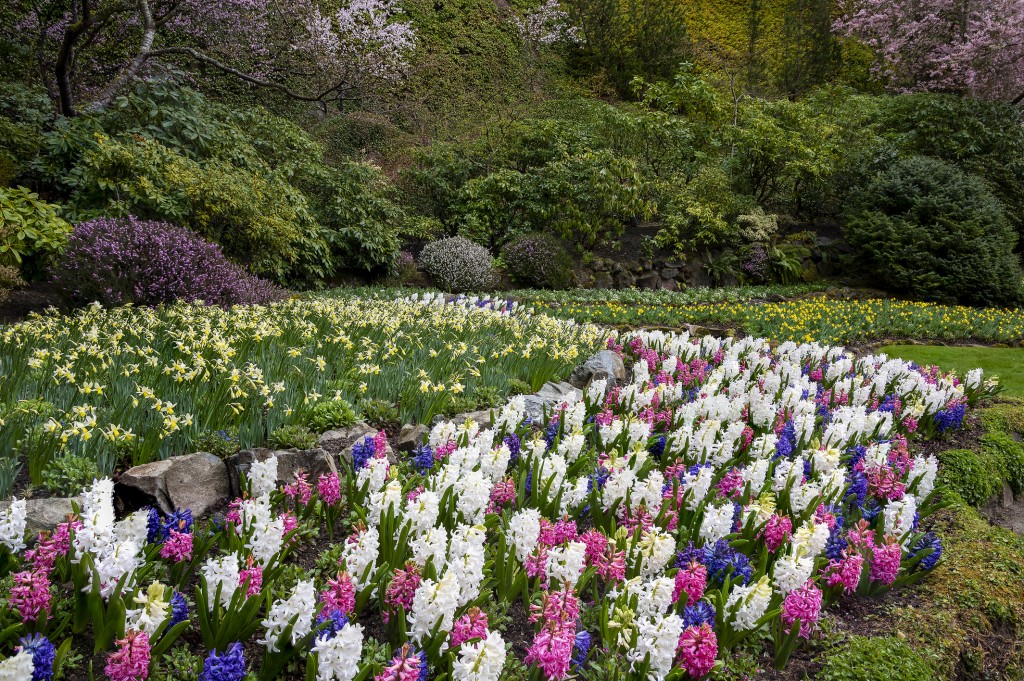 Hyacinth and Daffodils beds underplanted with Forget-Me-Not
Hyacinth and Daffodils beds underplanted with Forget-Me-Not
Then of course there is the peaceful Japanese Garden where pretty pink Erythronium revolutum dance amongst the ferns and the native Trillium ovatum (Coast trillium) can only be found by the observant visitor.
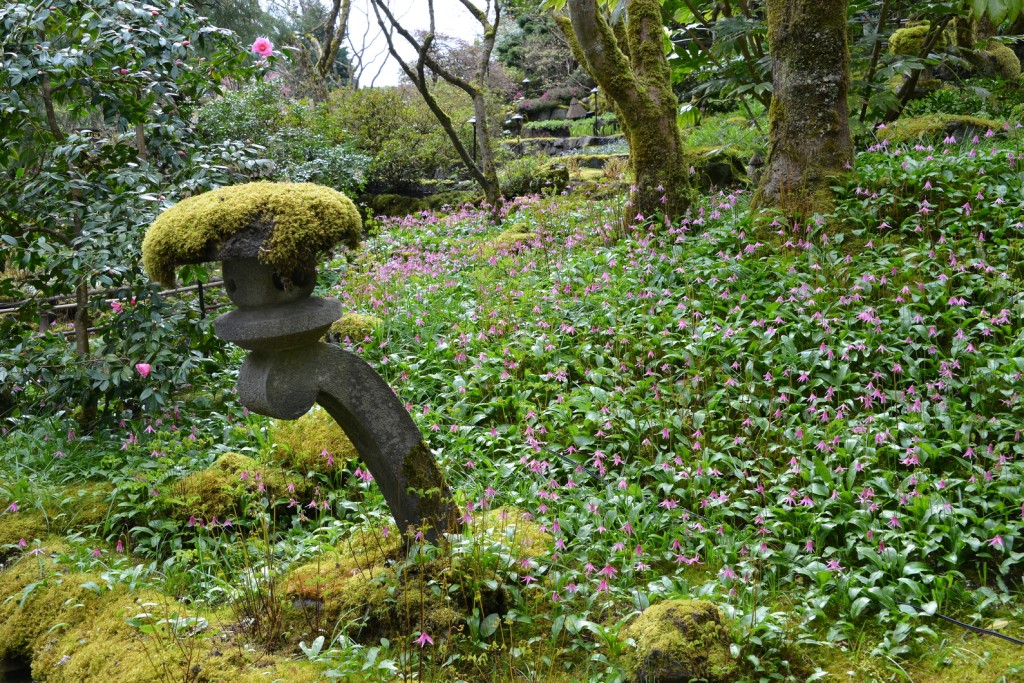 Pink Erythronium revolutum dance amongst the ferns in the Japanese Garden
Pink Erythronium revolutum dance amongst the ferns in the Japanese Garden
Plants, trees, and shrubs that are currently blooming
- Anemone (Grecian windflower)
- Anemonella (Rue anemone)
- Arabis
- Aubrieta
- Aucuba japonica (Spotted laurel)
- Bellis (English daisy)
- Bergenia (Elephant’s ears)
- Brunnera macrophylla
- Calluna (Scotch heather)
- Camellia
- Caltha (Marsh marigold)
- Chaenomeles (Flowering quince)
- Cornus mas (Cornelian cherry)
- Corylopsis (Winter hazel)
- Cotoneaster
- Crocus
- Cyclamen
- Daphne mezereum
- Daphne odora (Winter daphne)
- Epimedium (Barren wort)
- Eranthis hyemalis (Winter aconite)
- Erica (Heather)
- Erysimum (Wallflower)
- Erythronium tuolumnense (Trout lily)
- Forsythia
- Fritillaria elwesii (Fritillary)
- Fritillaria imperialis (Crown imperial)
- Fritillaria meleagris (Checkered lily)
- Galanthus nivalis (Snowdrop)
- Helleborus (Christmas rose)
- Hepatica nobilis
- Hyacinthus
- Leucojum (Snowflake)
- Lonicera fragrantissima (Honeysuckle)
- Lysichiton (Skunk cabbage)
- Magnolia x soulangeana
- Magnolia stellata (Star magnolia)
- Mahonia x media ‘Charity’ (Oregon grape)
- Muscari (Grape hyacinth)
- Myosotis (Forget-me-not)
- Nandina domestica (Heavenly bamboo)
- Narcissus (Daffodil)
- Ophiopogon planiscapus (Black mondo grass)
- Ornithogalum
- Polygala chamaebuxus
- Pulmonaria (Lungwort)
- Pulsatilla vulgaris (Lungwort)
- Pieris (Lily -of – the valley shrub)
- Primula (Primrose)
- Prostanthera rotundifolia (Mint bush)
- Prunus (Flowering cherry and plum)
- Ranunculus ficaria ‘Brazen Hussey’
- Rhododendron
- Ribes (Flowering currant)
- Scilla (Squill)
- Skimmia japonica
- Spiraea (Spirea)
- Tulipa
- Viburnum tinus
- Vinca (Periwinkle)
- Viola

